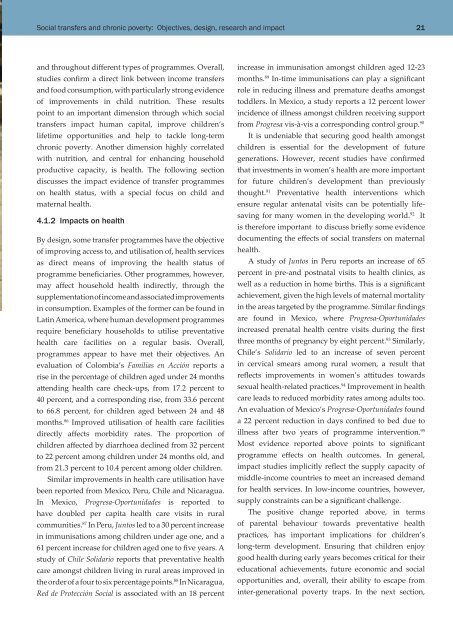Social transfers and chronic poverty
You also want an ePaper? Increase the reach of your titles
YUMPU automatically turns print PDFs into web optimized ePapers that Google loves.
<strong>Social</strong> <strong>transfers</strong> <strong>and</strong> <strong>chronic</strong> <strong>poverty</strong>: Objectives, design, research <strong>and</strong> impact<br />
21<br />
<strong>and</strong> throughout different types of programmes. Overall,<br />
studies confirm a direct link between income <strong>transfers</strong><br />
<strong>and</strong> food consumption, with particularly strong evidence<br />
of improvements in child nutrition. These results<br />
point to an important dimension through which social<br />
<strong>transfers</strong> impact human capital, improve children’s<br />
lifetime opportunities <strong>and</strong> help to tackle long-term<br />
<strong>chronic</strong> <strong>poverty</strong>. Another dimension highly correlated<br />
with nutrition, <strong>and</strong> central for enhancing household<br />
productive capacity, is health. The following section<br />
discusses the impact evidence of transfer programmes<br />
on health status, with a special focus on child <strong>and</strong><br />
maternal health.<br />
4.1.2 Impacts on health<br />
By design, some transfer programmes have the objective<br />
of improving access to, <strong>and</strong> utilisation of, health services<br />
as direct means of improving the health status of<br />
programme beneficiaries. Other programmes, however,<br />
may affect household health indirectly, through the<br />
supplementation of income <strong>and</strong> associated improvements<br />
in consumption. Examples of the former can be found in<br />
Latin America, where human development programmes<br />
require beneficiary households to utilise preventative<br />
health care facilities on a regular basis. Overall,<br />
programmes appear to have met their objectives. An<br />
evaluation of Colombia’s Familias en Acción reports a<br />
rise in the percentage of children aged under 24 months<br />
attending health care check-ups, from 17.2 percent to<br />
40 percent, <strong>and</strong> a corresponding rise, from 33.6 percent<br />
to 66.8 percent, for children aged between 24 <strong>and</strong> 48<br />
months. 86 Improved utilisation of health care facilities<br />
directly affects morbidity rates. The proportion of<br />
children affected by diarrhoea declined from 32 percent<br />
to 22 percent among children under 24 months old, <strong>and</strong><br />
from 21.3 percent to 10.4 percent among older children.<br />
Similar improvements in health care utilisation have<br />
been reported from Mexico, Peru, Chile <strong>and</strong> Nicaragua.<br />
In Mexico, Progresa-Oportunidades is reported to<br />
have doubled per capita health care visits in rural<br />
communities. 87 In Peru, Juntos led to a 30 percent increase<br />
in immunisations among children under age one, <strong>and</strong> a<br />
61 percent increase for children aged one to five years. A<br />
study of Chile Solidario reports that preventative health<br />
care amongst children living in rural areas improved in<br />
the order of a four to six percentage points. 88 In Nicaragua,<br />
Red de Protección <strong>Social</strong> is associated with an 18 percent<br />
increase in immunisation amongst children aged 12-23<br />
months. 89 In-time immunisations can play a significant<br />
role in reducing illness <strong>and</strong> premature deaths amongst<br />
toddlers. In Mexico, a study reports a 12 percent lower<br />
incidence of illness amongst children receiving support<br />
from Progresa vis-à-vis a corresponding control group. 90<br />
It is undeniable that securing good health amongst<br />
children is essential for the development of future<br />
generations. However, recent studies have confirmed<br />
that investments in women’s health are more important<br />
for future children’s development than previously<br />
thought. 91 Preventative health interventions which<br />
ensure regular antenatal visits can be potentially lifesaving<br />
for many women in the developing world. 92 It<br />
is therefore important to discuss briefly some evidence<br />
documenting the effects of social <strong>transfers</strong> on maternal<br />
health.<br />
A study of Juntos in Peru reports an increase of 65<br />
percent in pre-<strong>and</strong> postnatal visits to health clinics, as<br />
well as a reduction in home births. This is a significant<br />
achievement, given the high levels of maternal mortality<br />
in the areas targeted by the programme. Similar findings<br />
are found in Mexico, where Progresa-Oportunidades<br />
increased prenatal health centre visits during the first<br />
three months of pregnancy by eight percent. 93 Similarly,<br />
Chile’s Solidario led to an increase of seven percent<br />
in cervical smears among rural women, a result that<br />
reflects improvements in women’s attitudes towards<br />
sexual health-related practices. 94 Improvement in health<br />
care leads to reduced morbidity rates among adults too.<br />
An evaluation of Mexico’s Progresa-Oportunidades found<br />
a 22 percent reduction in days confined to bed due to<br />
illness after two years of programme intervention. 95<br />
Most evidence reported above points to significant<br />
programme effects on health outcomes. In general,<br />
impact studies implicitly reflect the supply capacity of<br />
middle-income countries to meet an increased dem<strong>and</strong><br />
for health services. In low-income countries, however,<br />
supply constraints can be a significant challenge.<br />
The positive change reported above, in terms<br />
of parental behaviour towards preventative health<br />
practices, has important implications for children’s<br />
long-term development. Ensuring that children enjoy<br />
good health during early years becomes critical for their<br />
educational achievements, future economic <strong>and</strong> social<br />
opportunities <strong>and</strong>, overall, their ability to escape from<br />
inter-generational <strong>poverty</strong> traps. In the next section,

















